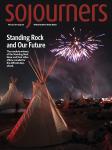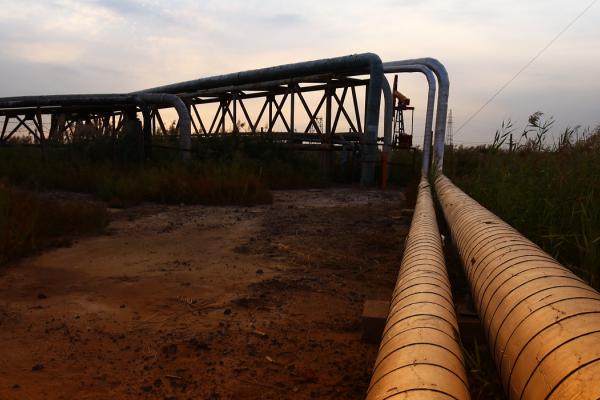THOSE BEARING witness at Standing Rock have become some of the most important, and most prophetic, leaders protecting God’s earth in America today—especially given the threat to our environment that Donald Trump represents.
There is no better example of what the struggle to protect God’s creation looks like now, and may look like in the future, than the “water protectors” at Standing Rock, who have put their bodies on the line for months to stop the Dakota Access pipeline from being built on sacred tribal lands and endangering the water supply of Indigenous people. Native Americans have been joined by people of every color and creed, including clergy (see “A Chorus of Resistance” in this issue) and military veterans, to prevent the construction from moving forward, despite brutal attacks from private security forces and state law enforcement.
The decision by the Army Corp of Engineers in early December to deny an easement for the pipeline route across Lake Oahe on the Missouri River, adjacent to the Standing Rock reservation, will temporarily halt the construction. But the head of the company building the pipeline has been a major contributor to Trump’s campaign, and with perhaps the most anti-environment president in memory about to enter office, the struggle is far from over.
“It is a temporary victory,” Denise McKay, a member of the Standing Rock Sioux told the Washington Post. “We’ve got to stay put and stay united.” Her daughter, Chelsea Summers, added, “everybody is still here for the long haul.”
On the list of those most vulnerable in Trump’s presidency—minorities, immigrants, and Muslims—we can add the poorest people on the planet, who will be the ones hit first and hardest by the catastrophe of climate change, which Trump will make more inevitable. Trump’s campaign rhetoric suggests that he may become the most hostile president in decades to protecting God’s creation. He has claimed that global warming is a hoax perpetrated by China, and that threats to the environment are not major problems. His incoming chief of staff, Reince Priebus, told the media that Trump operates under the assumption that climate science is mostly “a bunch of bunk.” Perhaps most tellingly, Trump chose a notorious climate denier, Scott Pruitt, to lead the Environmental Protection Agency.
Trump could not be taking office at a worse time in the struggle to save the planet and its inhabitants from the worst scenarios of climate change. In an act of resolve and hope, the world recently ratified a significant treaty committing the major carbon-producing countries to reducing their emission levels. The Paris agreement represents the first global step in the world coming together to tackle this threat. But during his campaign, Trump boasted that he would pull the U.S. out of the Paris accord, which would deal a crippling blow to the agreement’s effectiveness. We don’t have much time left to sufficiently reduce global emissions.
Fortunately, many states and large cities that are responsible for considerable amounts of U.S. carbon emissions have pledged to continue their own plans to reduce emissions in ways that conforms to the Paris targets. To the extent that the federal government actively impedes efforts to fight climate change or protect the environment, unyielding resistance at the state and local level will be necessary to mitigate the worst impacts of an anti-science, anti-religious federal policy under Trump.
And yes, this is a religious issue. Protecting the environment is a crucial task for those of us who believe God has commanded us to be good stewards of creation. To the extent that the environment comes under direct assault with the permission of the state, Christians of conscience need to ask themselves what they are willing to risk in solidarity with poor and vulnerable people—who are always impacted first and worst by environmental damage—and in defense of the Earth itself. The positive leadership of Pope Francis and other global faith leaders—on climate change and on the environment in general—is in direct conflict with the shameful anti-creation impulses of Donald Trump.
Standing Rock may represent a taste of the battles to come to protect creation during the Trump presidency. Yet Standing Rock also offers a blueprint that can be replicated and refined as encounters like these happen in the years ahead. It shows that large, multiracial coalitions are still willing and able to come together, first of all in prayer, and face enormous adversity, suffering, and even state-sanctioned violence in order to stand up nonviolently for the rights of disadvantaged groups and the health of the planet.
I pray that this spirit of prayerful resistance infuses and empowers us all in the months ahead as we carry out our promise to deliver a habitable planet to our descendants and a more equitable world for all of God’s children.

Got something to say about what you're reading? We value your feedback!

